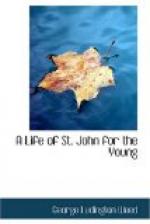At the time of which we write, two thousand years ago, Galilee was not inhabited wholly or chiefly by Jews. Other peoples, called Gentiles, were mixed with the Jewish race which continued to cultivate the land, and to tend the vineyards and olive-yards, and to dwell in the fisherman’s huts and moor their boats on the sandy beach. Some Jews were artisans, working at their trades in the smaller towns. But there were vast crowds of foreigners whose life was a great contrast to that of the Jews. Their customs were those of the nations to which they belonged. They spoke their own languages. They worshiped their own false gods. Their amusements were such as they were accustomed to in their distant homes. This was especially true of the Romans who had theatres, chariot races, and gladiatorial combats, by the peaceful waters of Galilee.
[Illustration: SEA OF GALILEE Old Engraving Page 21]
There were also Greeks who had sought new homes far from their native land. Many Arabians came from the deserts on swift horses, in roving bands in search of plunder. They wore brightly-colored dresses, and flashing swords and lances, carrying terror wherever they went. Egyptian travelers came with camels loaded with spices and balm. The bazaars were crowded with merchandise from India, Persia and Arabia. Long caravans from Damascus passed through Galilee, with goods for the markets of Tiberius on Lake Gennesaret, and the more distant cities of Jerusalem, Caesarea and Alexandria.
The gem of Galilee and of Palestine itself, is the Lake of Gennesaret, or the Sea of Tiberius. Its length is twelve and three-fourths miles; its greatest width, seven and one-fourth; its greatest depth, one hundred and sixty feet. On the west is the beautiful Plain of Galilee. On the east are rounded hills; and rugged mountains which rise nine hundred feet above the waters, with grassy slopes, and rocky cliffs barren and desolate. Bowers of olive and oleander deck the base of the hills whose sides yield abundant harvest. Around the lake is a level white beach of smooth sand. Gennesaret has been fittingly compared to a sapphire set in diamonds; and to a mirror set in a frame of richness and beauty.
“He hath made everything beautiful,” says Solomon concerning God. It is a well-known saying of Jewish writers, “Of all the seven seas God created, He made choice of none but the Lake of Gennesaret.” It was called the “beloved of God above all the waters of Canaan.”
The writer of this volume gratefully recalls blessed memories of Gennesaret, wishing his young friends could view with their own eyes those scenes which he asks them to behold through his own. Then could they join him in singing with the saintly McCheyne,
“How pleasant to me thy deep
blue wave,
O Sea of Galilee!
For the glorious One who came to save,
Hath often stood by thee.
* * * * *




